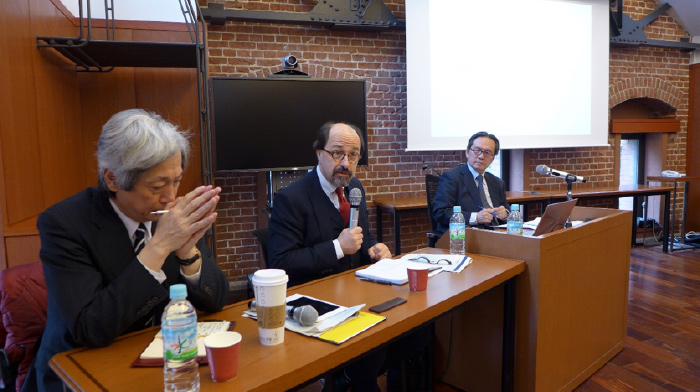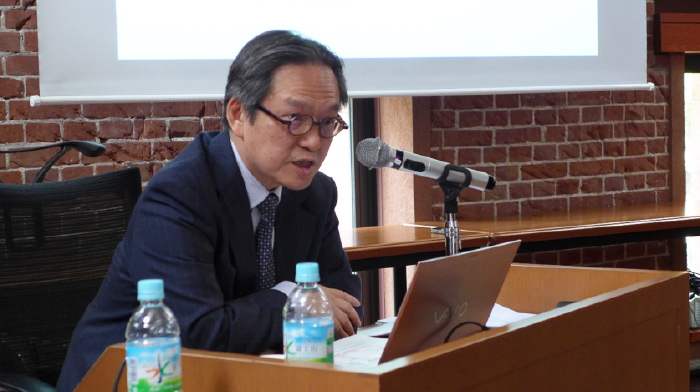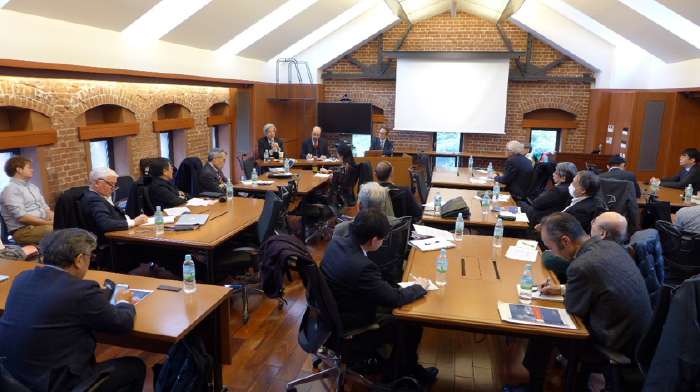SSU Forum with Dr. Fumihiko Yoshida and Mr. Bill Emmott
| Date: | Tuesday, February 28 2017, 10:30-12:00 |
|---|---|
| Venue: | Conference Room, 3rd Floor, Ito International Research Center |
| Subject | New Security Challenges under Emerging Technologies--Implications to Deterrence and Strategic Stability |
| Lecture: | Dr. Fumihiko Yoshida (Vice Director, RECNA) |
| Comment: | Mr. Bill Emmott (Chairman, Wake Up Foundation, Former Chief Editor of the Economist) |
| Language: | English |
| Hosted by: | Security Studies Unit, Policy Alternatives Research Institute, the University of Tokyo |
The Security Studies Unit was delighted to host a talked delivered by Dr. Fumihiko Yoshida, Vice Director of RECNA (Research Center for Nuclear Weapons Abolition at the University of Nagasaki, Japan), with the participation of eminent British journalist Bill Emmott as a discussant. The event was entitled “New Security Challenges under Emerging Technologies - Implications to Deterrence and Strategic Stability”.
Professor Kiichi Fujiwara, Director of the SSU, introduced the speakers. In particular he described Dr. Yoshida as a key writer on nuclear issues, who also was a regular contributor to public debates with columns and editorials on this subject while he was with the Asahi Shinbun, and Mr. Bill Emmott as a world-renown journalist who requires no introduction. Professor Fujiwara expressed his gratitude to the speakers for agreeing to hold the meeting.

Dr. Yoshida thanked the host and proceeded to illustrate the main point of his talk, namely the present technological change and its impact on defence and warfare. Indeed, as in the example of increasing precision of aerial bombing since WWII, technological change can dramatically alter the way in which war is waged. We now live at the cusp of a massive technological change, with numerous advancements which are considered by experts as imminent in the fields of nanotechnology, robotics, artificial intelligence, new materials and so on. Human societies have never experienced a period of such rapid technological change. There is also an important difference with the past: innovation today is taking place globally, not only within specific countries or economies. This implies that such new technologies will be proliferated, both to state and non-state actors, pushing all international actors to reconsider the meaning of security policies. Numerous military experts use the acronym MTR (Military Technological Revolution) to describe the situation.
Dr. Yoshida illustrated and analysed several opinions provided by international think tanks and research institutions about MTR, starting from SIPRI (Stockholm International Peace Research Institute). SIPRI argues that technology is a fundamental agent of change albeit the ways in which it will alter the military is yet to be discovered. It appears rather clearly that in the near future technological change will not only alter warfare, but the preconditions for peace and the nature itself of conflicts.
In a report produced for the White House entitled “Technology Trends Impacting the National Security” the US government recognised that leadership in science and technology has been the foundation of US national security at least since WWII. Therefore the US must remain ahead of its competitors if it wants to preserve its leadership, which is no longer guaranteed, and this will require additional investments in research. Furthermore, the report identifies the production of new technologies as a global knowledge flow, which is therefore no longer localised. This poses numerous challenges but also opportunities.
The Center for a New American Security has then produced a report authored by Robert O. Work and Shawn Brimley. Their main focus is robotisation, which will impact basic US concepts of defence and strategy, as well as re-shape US postures and the physical allocation of its military assets. Managing stability during periods of tensions could become more difficult. Other questions concern the kind of integration between manned and unmanned systems to be developed, with its organisational and legal-moral implications. For easy targets, it is possible to build autonomous systems that can identify, target, and engage enemy forces. However, DOD guidelines direct that a human must be in the loop for offensive lethal force decisions. Human decision making will likely be retained. However, when reaction time is critical or where communication links with human controllers are fragile, autonomous machines can be employed as more reliable decision makers.

Against this background, Dr. Yoshida remarked that the MTR may assume different traits, it may be rapid or gradual. However, it will leave old ways of doing war behind. Quoting Dr. James Lewis, Dr. Yoshida stated that new military technologies are destabilising: military innovation can create new dynamics in the calculation of risks among potential adversaries, leading them to reassess their views on deterrence and the role of nuclear weapons.
For example in the case of Russia and China, their concern is reinforced by a suspicion that the US will use new military technologies to achieve strategic effects without employing nuclear weapons. Therefore we need to review the current deterrence concept and paradigms.
Again quoting from Dr. Lewis, Dr. Yoshida remarked that we may need a new paradigm for strategic stability, which may require 1) a combination of shared understandings with potential opponents 2) unilateral confidence building measures, declaratory policies 3) potentially, seeking agreements on constraints.
How can all this affect the system of alliances with the US? The US puts emphasis on the third offset strategy, namely an investment strategy to retain technological superiority, and there alliances can play an important role as each alliance member, certainly a technologically advanced country like Japan, can contribute technologies, which can be pooled.
In conclusion, Dr. Yoshida offered some questions for further reflections on the matter, namely:
- a) Technologies create both risks and opportunities, how can we balance them?
- b) Will the third offset strategy provide more stability? Under what conditions?
- c) What will be the role of nuclear deterrence in the future?
- d) What are the best options of Japan?
These questions have no clear answer but they will become crucial in the near future.
Dr. Emmott opened his remarks by thanking the host, and praised Dr. Yoshida for his presentation. He stated that the world is undergoing a rather momentous change. The US administration just announced a proposal for a $50 billion increase in defence spending. This is a domestic political move, but also a strategic announcement which fits well in the third offset strategy framework. While the Obama doctrine in foreign policy, which was constructed around the “do not do stupid stuff” principle, was inherently cautious, we are now witnessing a new policy which may go in a different and more active direction. This can also be interpreted as a reaction to what is perceived as the MTR paradox: as the efficiency of methods of warfare increases, the effectiveness is perceived to have declined, particularly in terms of political outcomes in numerous crises (Iraq, Yemen, Syria, etc…). Under Obama, withdrawal seemed to be the answer, but the Trump administration is reacting to this state of affairs.

We also find ourselves in a geopolitical context in which Western alliances have been seen as weaker and less united than in the past. This is the product of Iraq and other military adventures, but also the post-2008 financial crash. This led, after a time lag, to a rise of popular dissent against the established political order and practices. This decline in confidence, strategically, politically, is producing its own feeling of frustration. Alliances are both needed, but simultaneously less reliable. How will this situation evolve? That could be an interesting question. The DOD is trying to reassure alliances, in Europe and in Japan, that hardline re-discussion of the US international commitments will not occur, contrary to some electoral promises. We will continue to see that change of tone in the future. We will also see an increase in European defence spending, coupled with the development of more autonomous technological capabilities.
Finally we need to get a sense of the evolving threats, and at the top of that list, for the US administration, is China.
Here the frontlines are the technological gap with China and the strategic balance both in the Asia Pacific region, and globally. The challenge is to understand the variables of the US-China relations, and particularly concerning technological and military matters, the question is: What is it in technological terms which can really operate as a deterrent against China?
Furthermore, the MTR opens new fronts in term of asymmetric warfare: How is it possible to make technologies more effective with adversaries like ISIS? What about North Korea?
In conclusion Dr. Emmott reiterated the idea that our current situation poses a number of paradoxes, many of which constitute quite steep challenges for the transformation of alliances.

